
Decision Making Tasks in Psychology Research
In psychology research, decision making tasks are used to gain a better understanding of decision making, a cognitive process in which individuals make a choice or decide upon a course of action out of several alternatives. Researchers rely on Decision Making Tasks to assess how individuals make choices, the underlying cognitive processes and the factors influencing it.
Key Sections:
What are Decision Making Tasks?
Decision-making tasks are cognitive tasks designed to measure decision-making competences, requiring participants to choose among alternatives under conditions of uncertainty (Yu, 2014; Schiebener et al., 2013). Studying decision-making is crucial as it provides insights into underlying cognitive functions, its clinical implications, and more.
Why are Decision Making Tasks Important?
Decision making tasks not only help in gaining insights into the complex processes involved in decision-making, but also help in identifying different aspects of decision-making behavior (Ličen, M., & Slapničar, S., 2022).. Here are a few:
- Risk aversion: The tendency for individuals to prefer a choice that is perceived as having low uncertainty over choices that are as highly uncertain.
- Impulsivity: The behavioral tendency of making choices or acting without considering or thinking about the consequences ahead of time.
- Myopia: A cognitive bias in which individuals focus on immediate rewards or outcomes by ignoring or overlooking future consequences or information not immediately at hand.
- Social preferences: It is the tendency of individuals to consider not just their own wellbeing, but also of others.
- Cognitive biases: Any systematic and unconscious cognitive inclinations that occur in individuals while processing an information.
- Neural Basis: Utilizing such tasks enables researchers to investigate the neural basis of decision-making and develop therapies for brain disorders (Christopoulos et al., 2018)
Types and Examples of Decision Making Tasks
Decision-making tasks are categorized into different classes, each studying different processes of decision making. Here are a few:
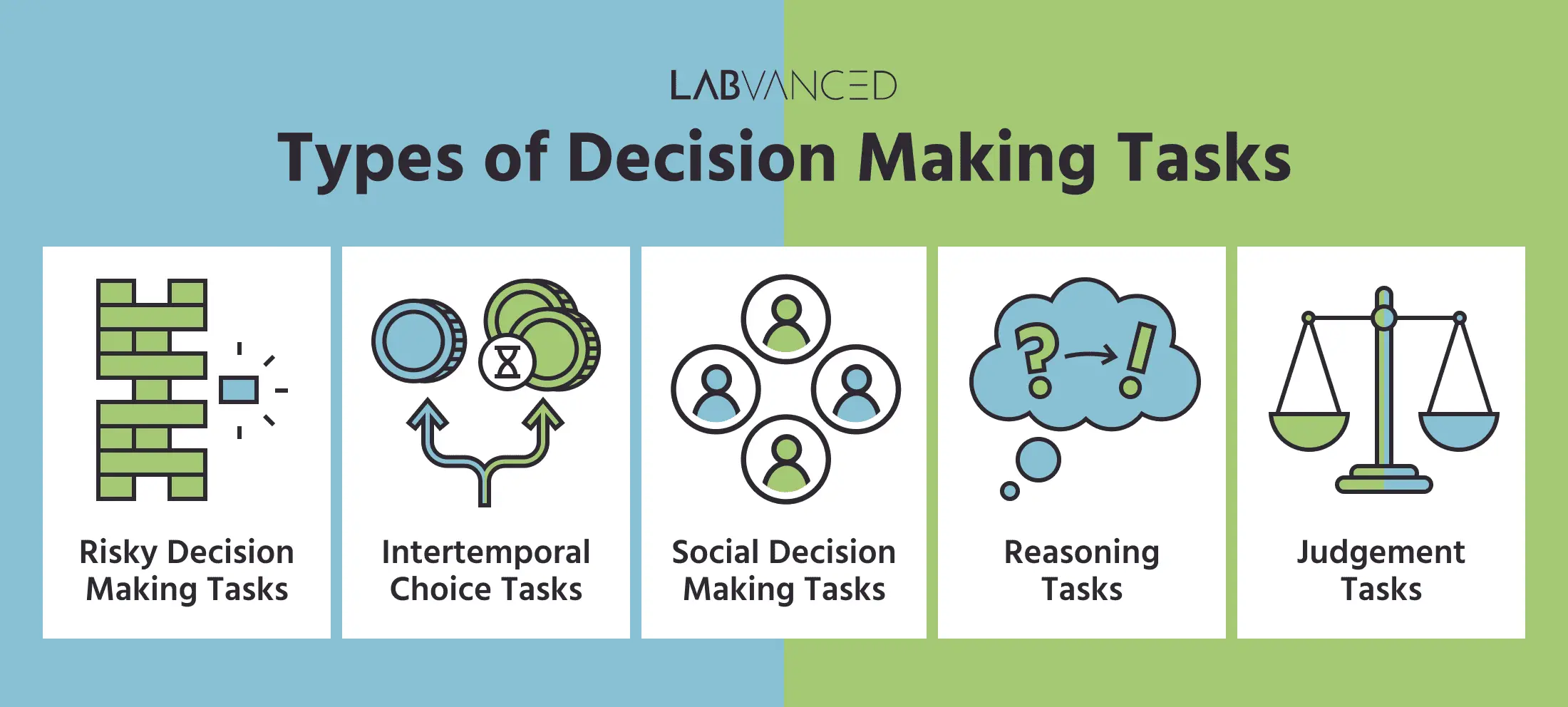
Risky Decision Making Tasks
Risky Decision Making occurs when an individual is involved in situations where a choice has an associated risk, meaning potential gains and losses are tied to the available options. The decision-maker may also be aware of the probabilities of the possible outcomes resulting from the decision. For instance, gambling on a roulette wheel and dice games involve risk with probabilities (Xue et al., 2010; Buelow et al., 2022).
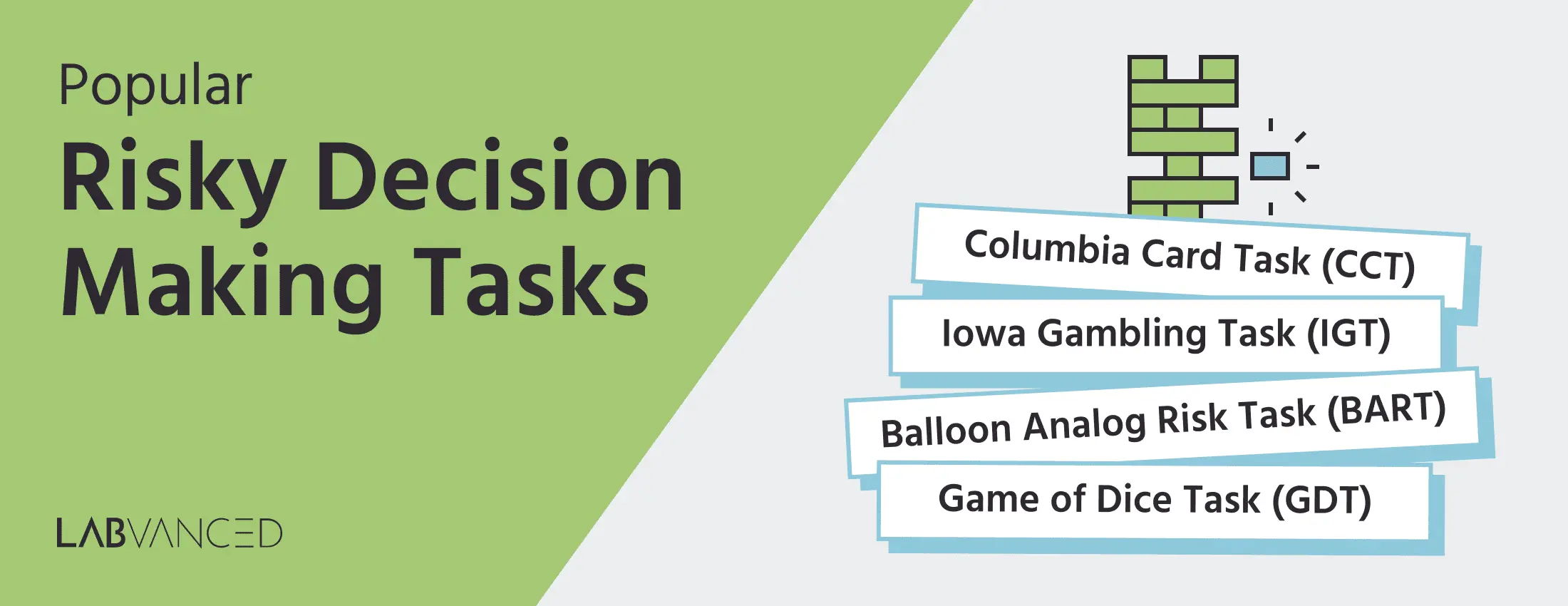
Risky Decision Making Tasks assess a person's natural or instinctive tendencies in taking risks across various situations and, when combined with advanced technologies, can even identify brain regions that are activated during decision-making (Chowdhury et al., 2023; Ernst, M., 2002).
Examples of Risky Decision Making Tasks are:
Balloon Analog Risk Task (BART)
The Balloon Analogue Risk Task (BART) is a sequential experiment designed to analyze risk-taking behavior in individuals. In this task, participants are presented with a virtual balloon that they are encouraged to pump in order to increase the monetary value they gain. However, each pump carries the risk of the balloon bursting, which would result in the participant losing all the accumulated value (Coon & Lee, 2021).
Iowa Gambling Task (IGT)
The Iowa Gambling Task (IGT) is a task that evaluates the decision-making process through a card game where participants choose cards from four different decks that offer varying rewards and penalties. Upon choosing a card from a deck, participants are presented with immediate feedback about how much money they gained or lost. Based on that, the participant is expected to adapt their choice and adopt a pattern of choices that lead to higher rewards and lower losses (Hultman et al., 2022; Aram et al., 2019).
Columbia Card Task (CCT)
The Columbia Card Task evaluates decision-making under risk and uncertainty utilizing cards. Participants are displayed 32 cards, and instructed to turn over cards for points until they wish to stop and collect the points, or until a loss card is turned over and the amount of the loss is subtracted from their point (Sambol et al., 2024).
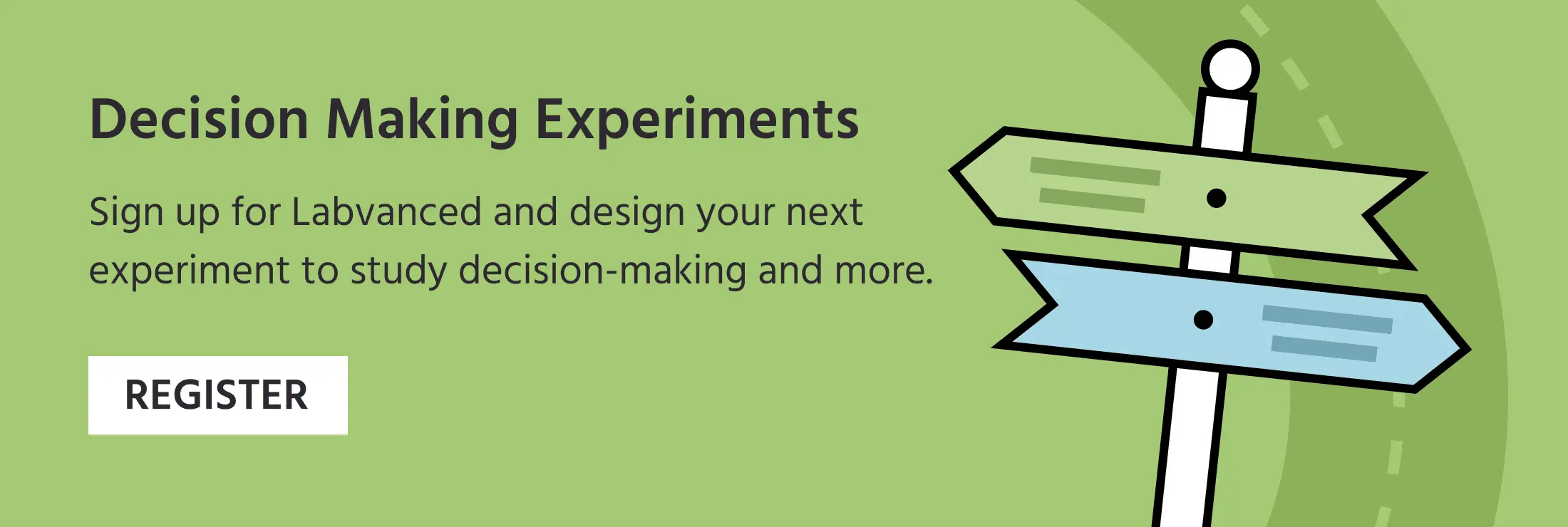
Game of Dice Task (GDT)
The Game of Dice Task is commonly used to assess the risk preferences of individuals. Participants are provided with a dice and are required to predict what number(s) will come up when they roll it. They make decisions by choosing from different options, each representing a varying level of risk and reward (with higher gains having lower probabilities of success, and vice versa) (Wood et al, 2016).
Intertemporal Choice Tasks
Intertemporal choice is the decision making process in which individuals choose from outcomes that are available at different points in time, usually immediate availability or delayed availability. The different factors that could influence this choice include the individual's state of mind, how the decision is framed, and emotional factors (Lempert & Phelps, 2016).
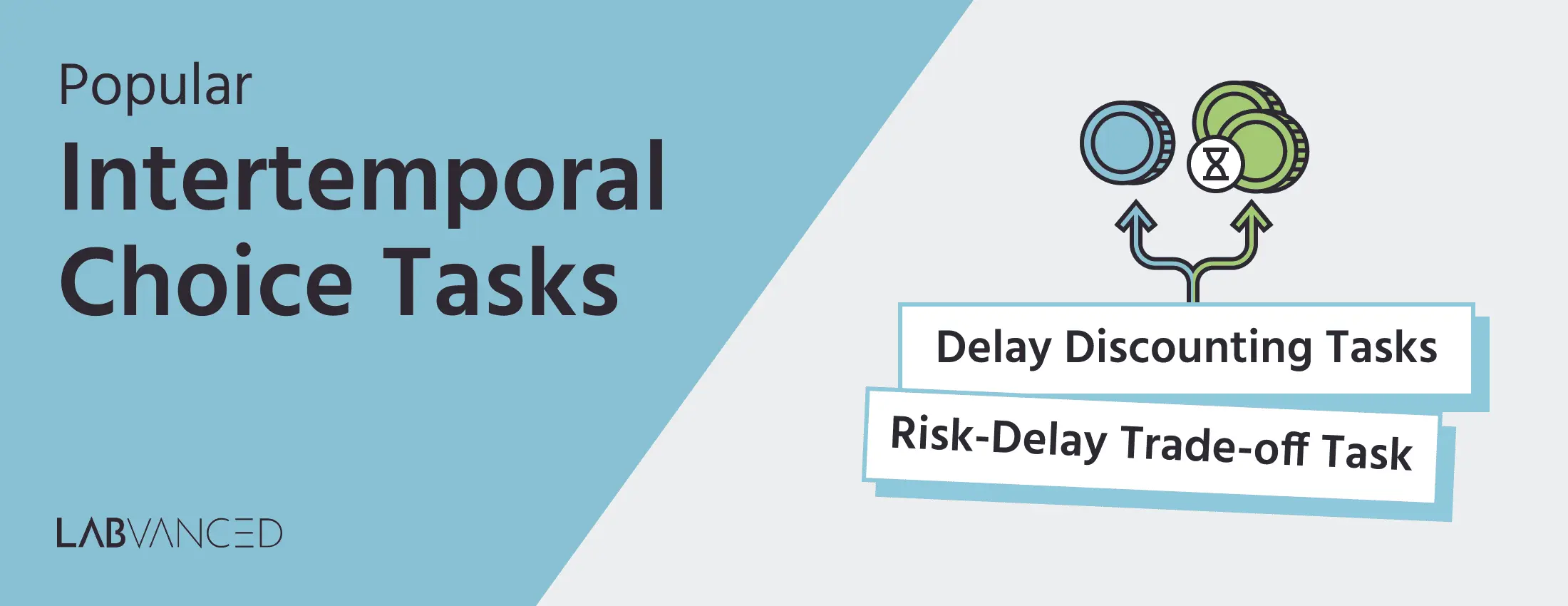
Examples of Intertemporal Choice Tasks are:
Delay Discounting Tasks
In the Delay Discounting Task, participants are required to choose between a smaller, immediate reward and a larger, delayed reward. It is often observed that delayed rewards are discounted (or valued less) than the more immediate outcomes (Gui et al, 2016). In this task, the outcomes or rewards are guaranteed, ie. the participant is not faced with any risk of losses.
- Try it out or import it to your account https://www.labvanced.com/page/library/39102
Risk-Delay Trade-off Task
In the Risk-Delay Trade-off Task, participants evaluate the value of immediate versus delayed rewards while also having to consider the uncertainty (ie. the risk) of receiving the promised reward. Unlike the Delay Discounting Task, the rewards are not guaranteed, introducing a risk-taking component to the decision-making process (Christensen et al., 1998).
Social Decision Making Tasks
Social Decision Making refers to the process wherein an individual not only considers their own best interest when making a decision, but also of others. Social Decision Making Tasks assess how decisions are influenced by the intentions, opinions, and preferences of others. These tasks are crucial in understanding decision making processes under complex social situations (Coccia et al., 2022; Panico et al., 2024).
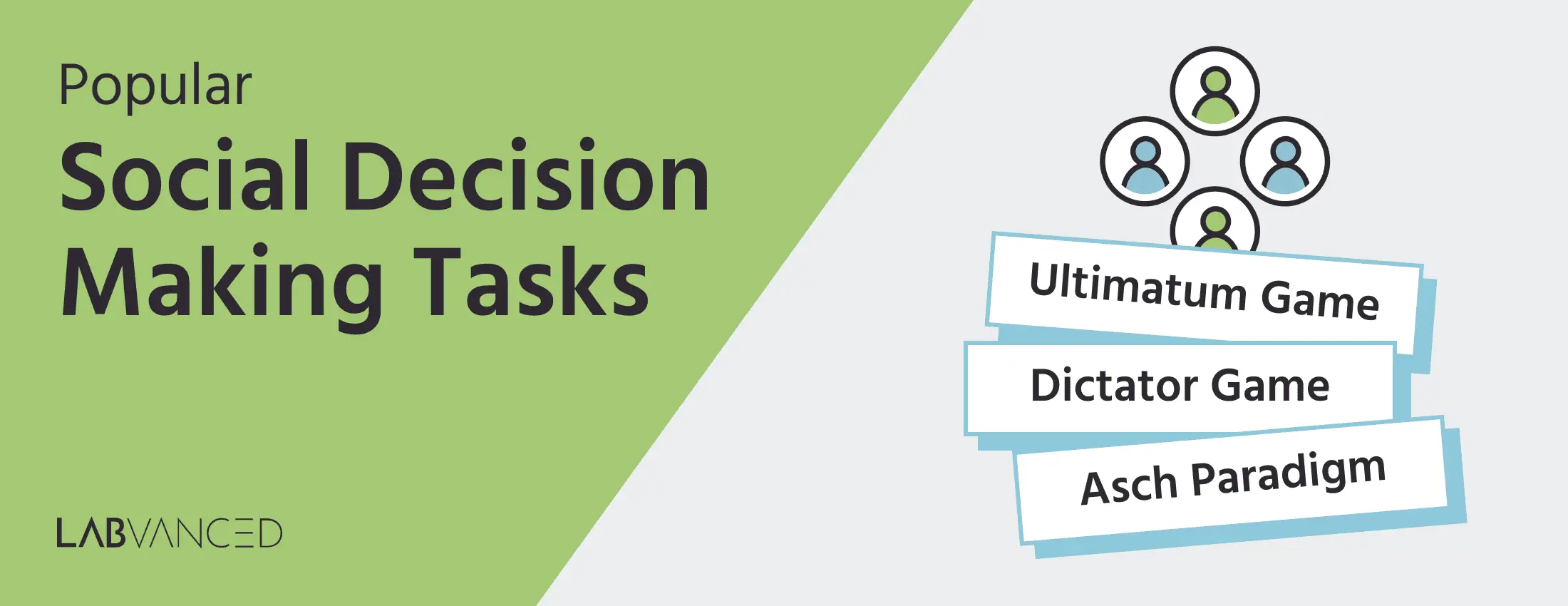
Commonly used social decision making tasks are:
Ultimatum Game
The Ultimatum Game is an experiment in which there are two players who decide how to split a sum of money or resources. One of the players (the proposer) suggests a division of resources and the other player (the responder) can either accept or reject the offer. The game can have different variants that could influence the players’ decisions. For instance, in some versions, the participant can play with an actual participant, while in other cases they play against an automated-virtual opponent without knowing that the other participant is not a real person. (Krawczyk, 2018).
- Try it out or import it to your account https://www.labvanced.com/page/library/3321
Dictator Game
The Dictator Game is a variant of the ultimatum game, also involving two players. One of the players (the dictator) is given a fixed amount of money, which they must divide between themselves and the second player (the recipient). The recipient has no say in the division of the amount and must accept whatever amount the dictator allots. The game is often considered as a measure of fairness and altruism (Franzen & Pointner, 2012; Leder & Schütz, 2018).
Asch Paradigm
The Asch Paradigm is a series of experiments on conformity (ie. the tendency to change one’s beliefs or actions to better fit to those of the group). The Asch experiments aim to assess whether the individual’s decision making is subject to conformity under social pressure (Kundu & Cummins, 2013).
- Try it out or import it to your account https://www.labvanced.com/page/library/38206
Reasoning Tasks
In Reasoning Tasks, participants make decisions and answer questions by utilizing various forms of supporting knowledge, including graphs, texts, and visuals.
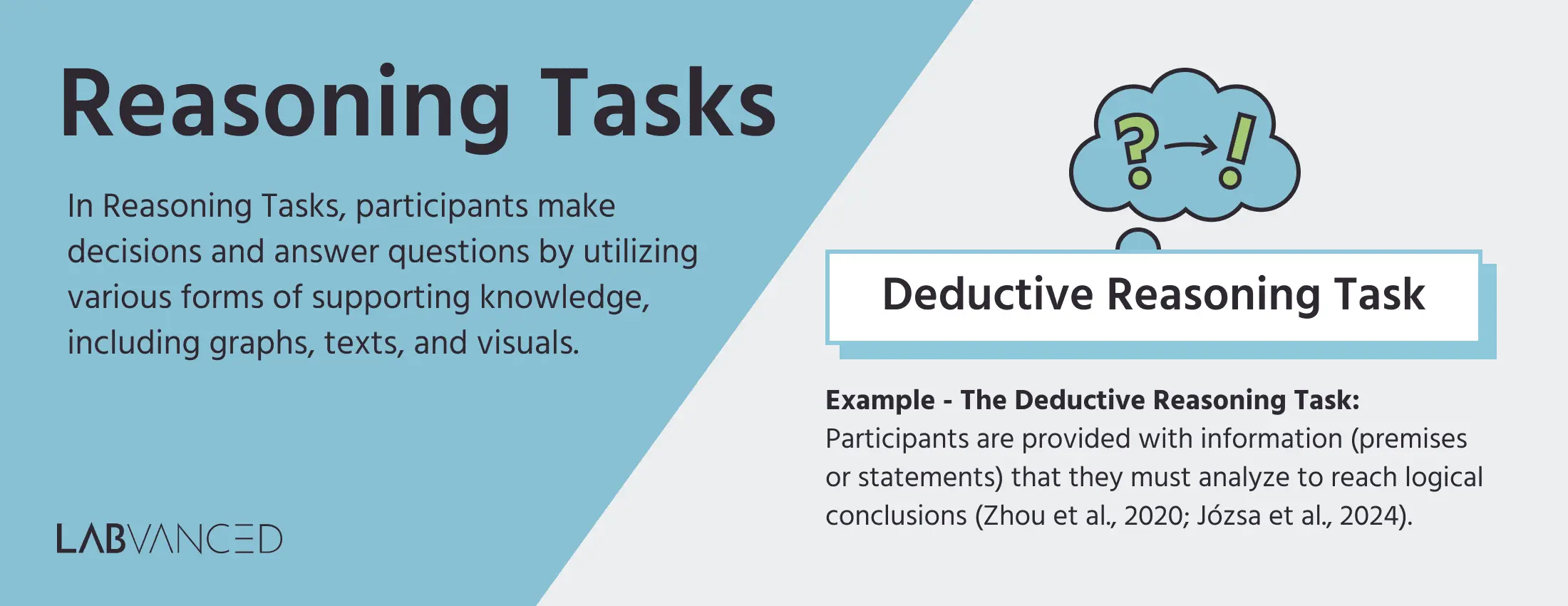
A common example is the deductive reasoning task, where participants are provided with information (premises or statements) that they must analyze to form logical conclusions (Zhou et al., 2020; Józsa et al., 2024). A decision is expected to be made by logically drawing conclusions.
Judgment Tasks
In Judgment Tasks, participants make decisions by evaluating a situation based not only on the available information but also by integrating their personal values and experiences. These tasks typically do not have a single correct answer.
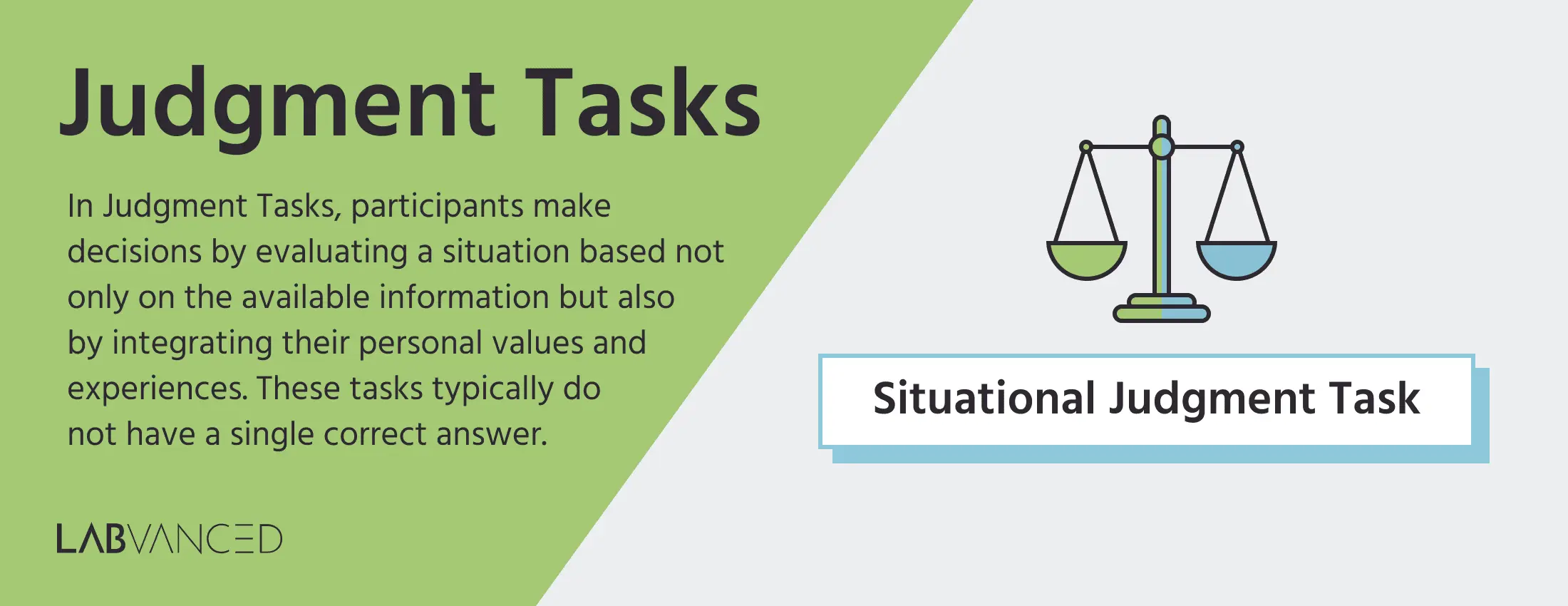
An example is the situational judgment task, where participants are presented with a description of a problem and asked to select the most appropriate action for that particular situation (Krabbe, 2017; Lievens et al., 2008).
Financial Decision Making Tasks
The framing effect is a cognitive bias in which people decide between options based on whether the options are presented with positive or negative connotations. Participants are presented with the same information framed differently to see how framing influences financial decisions.

Additional Terminology
Cognitive Decision Making Tasks
Cognitive decision making tasks sounds like a general term, but it can be used to describe tasks where the made decisions do not have emotional (affective), positive or negative, consequences. Thus, the participant makes a choice, but the decision has no felt consequences, like a gain or a loss (van Duijvenvoorde, A. C., Jansen, B. R., Visser, I., & Huizenga, H. M., 2010). Thus, any task that involves decisions but does not lead an emotional impact on the participant can be considered as a cognitive decision making task. An example of a task would be logic-based tasks or even probability-based tasks.
Affective Decision Making Tasks
Affective decision making tasks encompass tasks wherein the decisions a participant makes lead to consequences that can have an impact on emotion or on one’s affective state. For instance, if a decision in a task leads to gains or losses, then it can be considered to be a part of an affective decision making task. A popular and commonly used affective decision making task is the Iowa Gambling Task (van Duijvenvoorde, A. C., Jansen, B. R., Visser, I., & Huizenga, H. M., 2010).
Conclusion
Decision-making tasks are essential for understanding the complexities of human behavior. Researchers use them to gain insights into the processes, underlying mechanisms, influencing factors, and broader implications of decision-making. These tasks have become widely utilized with practical implications in many fields such as psychology, education, healthcare and more!
References
Aram, S., Levy, L., Patel, J. B., Anderson, A. A., Zaragoza, R., Dashtestani, H., Chowdhry, F. A., Gandjbakhche, A., & Tracy, J. K. (2019). The Iowa Gambling Task: A review of the historical evolution, scientific basis, and use in functional neuroimaging. Sage Open, 9(3). https://doi.org/10.1177/2158244019856911
Buelow, M. T., Jungers, M. K., Parks, C., & Rinato, B. (2022). Contextual factors affecting risky decision making: The influence of music on task performance and perceived distraction. Frontiers in Psychology, 13. https://doi.org/10.3389/fpsyg.2022.818689
Chowdhury, A., Sharma, S. S., Arjun, B. S., Pandya, H. J., Shankaranarayana Rao, B. S., & Laxmi, T. R. (2023). Risky decision-taking task: A novel paradigm to assess the risk-taking behaviour in rats predisposed to early-life stress. Journal of Neuroscience Methods, 392, 109864. https://doi.org/10.1016/j.jneumeth.2023.109864
Christensen, J., Parker, S., Silberberg, A., & Hursh, S. (1998). Trade‐offs in choice between risk and delay depend on monetary amounts. Journal of the Experimental Analysis of Behavior, 69(2), 123–139. https://doi.org/10.1901/jeab.1998.69-123
Christopoulos, V. N., Andersen, K. N., & Andersen, R. A. (2018). Extinction as a deficit of the decision-making circuitry in the posterior parietal cortex. Handbook of Clinical Neurology, 163–182. https://doi.org/10.1016/b978-0-444-63622-5.00008-5
Coccia, G., La Greca, F., Di Luca, M., & Scheggia, D. (2022). Dissecting social decision-making: A spotlight on oxytocinergic transmission. Frontiers in Molecular Neuroscience, 15. https://doi.org/10.3389/fnmol.2022.1061934
Coon, J., & Lee, M. D. (2021). A Bayesian method for measuring risk propensity in the balloon analogue risk task. Behavior Research Methods, 54(2), 1010–1026. https://doi.org/10.3758/s13428-021-01634-1
Ernst, M. (2002). Decision-making in a risk-taking task: a pet study. Neuropsychopharmacology, 26(5), 682–691. https://doi.org/10.1016/s0893-133x(01)00414-6
Franzen, A., & Pointner, S. (2012). Anonymity in the dictator game revisited. Journal of Economic Behavior & Organization, 81(1), 74–81. https://doi.org/10.1016/j.jebo.2011.09.005
Gui, D.-Y., Li, J.-Z., Li, X., & Luo, Y. (2016). Temporal Dynamics of the interaction between reward and time delay during intertemporal choice. Frontiers in Psychology, 7. https://doi.org/10.3389/fpsyg.2016.01526
Hultman, C., Tjernström, N., Vadlin, S., Rehn, M., Nilsson, K. W., Roman, E., & Åslund, C. (2022). Exploring decision-making strategies in the Iowa gambling task and rat gambling task. Frontiers in Behavioral Neuroscience, 16. https://doi.org/10.3389/fnbeh.2022.964348
Józsa, K., Oo, T. Z., Borbélyová, D., & Podráczky, J. (2024). Deductive reasoning skills in children aged 4–8 years old. Journal of Intelligence, 12(3), 33. https://doi.org/10.3390/jintelligence12030033
Krabbe, P. F. M. (2017). Constructs and Scales. The Measurement of Health and Health Status, 67–89. https://doi.org/10.1016/b978-0-12-801504-9.00005-2
Krawczyk, D. C. (2018). Social Cognition. Reasoning, 283–311. https://doi.org/10.1016/b978-0-12-809285-9.00012-0
Kundu, P., & Cummins, D. D. (2013). Morality and conformity: The asch paradigm applied to moral decisions. Social Influence, 8(4), 268–279. https://doi.org/10.1080/15534510.2012.727767
Leder, J., & Schütz, A. (2018). Dictator game. Encyclopedia of Personality and Individual Differences, 1–4. https://doi.org/10.1007/978-3-319-28099-8_652-1
Lempert, K. M., & Phelps, E. A. (2016). The malleability of Intertemporal choice. Trends in Cognitive Sciences, 20(1), 64–74. https://doi.org/10.1016/j.tics.2015.09.005
Ličen, M., & Slapničar, S. (2022). Can process accountability mitigate myopic biases? An experimental analysis. Journal of Management Control, 33(1), 1-26.
Lievens, F., Peeters, H., & Schollaert, E. (2008). Situational judgment tests: A review of recent research. Personnel Review, 37(4), 426–441. https://doi.org/10.1108/00483480810877598
Panico, F., Ferrara, A., Sagliano, L., & Trojano, L. (2024). The involvement of rtpj in intention attribution during Social Decision making: A TMS study. Cognitive, Affective, & Behavioral Neuroscience, 24(4), 755–765. https://doi.org/10.3758/s13415-024-01188-7
Sambol, S., Suleyman, E., & Ball, M. (2024). The assessment of affective decision‐making: Exploring alternative scoring methods for the Balloon Analog Risk Task and Columbia Card Task. Journal of Behavioral Decision Making, 37(1), e2367.
Schiebener, J., Schulte, F. P., Hofmann, J., & Brand, M. (2013). A versatile task for assessing decision-making abilities: The truck dispatcher framework. Applied Neuropsychology: Adult, 21(4), 241–259. https://doi.org/10.1080/09084282.2013.798735
van Duijvenvoorde, A. C., Jansen, B. R., Visser, I., & Huizenga, H. M. (2010). Affective and cognitive decision-making in adolescents. Developmental Neuropsychology, 35(5), 539-554.
Wood, M., Black, S., & Gilpin, A. (2016). The effects of age, priming, and working memory on decision-making. International journal of environmental research and public health, 13(1), 119.
XUE, G., CHEN, C., LU, Z.-L., & DONG, Q. (2010). Brain imaging techniques and their applications in decision-making research. Acta Psychologica Sinica, 42(1), 120–137. https://doi.org/10.3724/sp.j.1041.2010.00120
Yu, A. J. (2014). Decision-making tasks. Encyclopedia of Computational Neuroscience, 1–8. https://doi.org/10.1007/978-1-4614-7320-6_314-1
Zhou, M., Duan, N., Liu, S., & Shum, H.-Y. (2020). Progress in neural NLP: Modeling, learning, and reasoning. Engineering, 6(3), 275–290. https://doi.org/10.1016/j.eng.2019.12.014